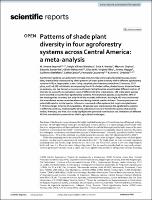Patterns of shade plant diversity in four agroforestry systems across Central America: a meta‑analysis
Fecha de publicación
26-05-2023Autor
Esquivel, M. Jimena
Vílchez-Mendoza, Sergio
Ospina Pedraza, Mayra A
Somarriba, Eduardo
Virginio Filho, Elias de Melo
Detlefsen Rivera, Guillermo
Casanoves, Fernando
y 5 autores más
Tipo
Artículo
Metadatos
Mostrar el registro completo del ítemResumen
Agroforestry systems can potentially increase tree diversity within agricultural landscapes, but to date, there is little understanding of the patterns of shade plant diversity within different agroforestry systems (AFS) at large spatial scales. Using compiled plant inventory data (from 23 sources, 2517 plots, and 148,255 individuals) encompassing four AFS (shaded coffee; shaded cocoa; dispersed trees on pastures; and live fences) across six countries in Central America we estimated different metrics of diversity to assess the conservation value of different AFS for shade plants. 458 shade plant species were recorded across the four agroforestry systems. Primary forest species accounted for 28% of the shade species recorded, but only 6% of the recorded individuals. No single AFS was consistently the most diverse across countries when considering rarefied species richness. Trees on pastures can potentially reach a similar species richness as cocoa and coffee systems but require sampled areas 7–30 times larger. In terms of composition, 29 species were shared across the agroforestry systems in different countries, illustrating the strong selection pressure of farmers for species that provide timber, firewood, and fruit. Our study highlights the potential contribution and limitations of different AFS for tree diversity conservation within agricultural landscapes.
Palabras clave
ORCID-ID
https://orcid.org/0000-0003-2373-6371
https://orcid.org/0000-0002-9371-9799
https://orcid.org/0000-0001-8765-9382
Editor
Nature
Es parte de
Scientific Reports
URI enlace
https://doi.org/10.1038/s41598-023-35578-7


